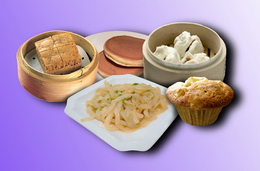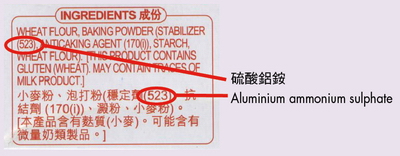
Food Safety Focus (35th Issue, June 2009) – Incident in Focus
Aluminium in Food
Reported by Ms. Waiky WONG, Scientific Officer,
Risk Assessment Section, Centre for Food Safety
Last month, the Centre for Food Safety (CFS) released the Risk Assessment Study on Aluminium in Food, which revealed that high levels of aluminium were commonly found in a range of food products, probably a result of using aluminium-containing food additives. Items containing high aluminium levels included jellyfish, steamed bread/bun/cake, and some bakery products such as muffins, pancake and waffle.

Examples of items that were found with high levels of aluminium
The study was conducted in the light of the latest evaluation by the Joint Food and Agriculture Organization/ World Health Organization Expert Committee on Food Additives (JECFA) that the safe intake level (i.e. provisional tolerable weekly intake (PTWI)) was lowered by seven folds to 1 mg/kg body weight (bw) for aluminium. Recent study revealed that dietary exposure of some Europeans may exceed this new PTWI. Food authorities in Canada, Japan and Australia are also examining their local situation.
Aluminium-containing Food Additives
Aluminium-containing food additives have been used in food processing with a variety of functions for over a century and are permitted to be used in many countries such as the United States, the European Union, Australia, Japan and Mainland China. They are commonly used as raising agent in steamed cake/bread and bakery products, anticaking agent in powder mix, colouring matter in candy-coated confectionery, and in the East, as firming agent in jellyfish. Food with aluminium-containing food additives is regarded as the main dietary source of aluminium of the general population.
Moreover, aluminium levels may vary widely among bakery products, depending on whether aluminium-containing food additives are used in such products and their amounts added. Bakery products with low to high levels of aluminium as revealed by the study are grouped in the table below.
Aluminium contents among various bakery products
| Levels of aluminium (mg/kg) | ||
|---|---|---|
| Generally low (mean ≦ 10) |
Generally medium (10 < mean ≦100) |
Generally high (mean >100) |
|
Baked barbecue pork puff Bun or roll Egg tart Wafers Wheat bread White bread |
Cakes Chinese walnut cookies or similar products Cookies and biscuits Doughnut Fruit tart |
Coconut tart Muffin Pancake / Waffle |
Remarks: Levels of aluminium are drawn from a limited number of samples tested in the study.
Health Effects of Aluminium
No acute toxicity by the oral exposure to aluminium has been reported in general population and aluminium is not regarded as a human carcinogen. Moreover, the dietary exposure to aluminium is not considered to pose a risk for developing Alzheimer's disease. However, aluminium compounds have demonstrated reproductive and developmental toxicity in experimental animals.
Local Dietary Exposure to Aluminium
Average dietary exposure to aluminium of the local population revealed by our study was 0.6 mg/kg bw/week (i.e. 60% of the PTWI). Thus, it does not warrant changes in usual dietary advice for average individuals, but people, particularly children, who regularly consume food using aluminium-containing food additives such as steamed bread/bun/cake, some bakery products and jellyfish, may be of higher risk. Nevertheless, occasional exposure above the PTWI would not have health consequences provided that the average intake does not continuously exceed the PTWI.
Key Points to Note
- Food items, such as jellyfish, steamed cakes and muffins, may contain high levels of aluminium.
- Efforts should be made to reduce the dietary intake of aluminium in general population.
- A balanced diet should be maintained to avoid excessive exposure to aluminium from a small range of food items.
Collaboration with Trade to Reduce Aluminium Exposure for the Population
The CFS has worked closely with the trade to devise the Guidelines on the Use of Aluminium-containing Food Additives and urges the trade to adopt measures stipulated in the Guidelines to reduce the aluminium content in food. On the other hand, the Codex Alimentarius Commission is reviewing the standards of aluminium containing food additives with a view of lowering the aluminium exposure in general population. The CFS will continue to monitor the situation and the international development.
Advice to Trade
- Reduce the use of aluminium-containing food additives in preparing food or replace them with other alternatives as far as possible.
- Develop alternative techniques to reduce the use of aluminium containing food additives during food processing.
- Provide accurate information on food labels including specific food additives used.
Advice to Public
- Maintain a balanced diet to avoid excessive exposure to aluminium from a small range of food items, particularly jellyfish, steamed cakes and muffins.
- Make informed food choices by making reference to the information on the ingredient list, including the food additives used and their International Numbering System for Food Additives (INS) number .
Examples of aluminium-containing food additives
| INS Number | Food Additive |
|---|---|
| 173 | Aluminium |
| 520 | Aluminium sulphate |
| 521 | Aluminium sodium sulphate |
| 522 | Aluminium potassium sulphate |
| 523 | Aluminium ammonium sulphate |
| 541 | Sodium aluminium phosphate |
| 541(i) | Sodium aluminium phosphate (acidic) |
| 541(ii) | Sodium aluminium phosphate (basic) |
| 554 | Sodium aluminosilicate |
| 555 | Potassium aluminium silicate |
| 556 | Calcium aluminium silicate |
| 559 | Aluminium silicate |
| 1452 | Starch aluminium octenyl succinate |

Food label showing a list of ingredients with aluminium-containing food additives

